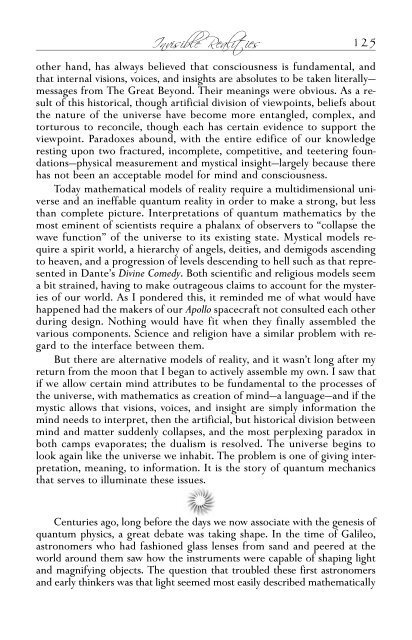edgar-mitchell
edgar-mitchell
edgar-mitchell
Create successful ePaper yourself
Turn your PDF publications into a flip-book with our unique Google optimized e-Paper software.
Into the Vacuum 63<br />
racket of latches closing and joining the two spacecraft. For the time being<br />
we were back on a nominal mission to the moon. Here lives and missions<br />
were saved by improvisation.<br />
For three days we flew across the abyss of space at the rate of several<br />
miles per second, making only a small adjustment along the way to assure<br />
our arrival at the precise point behind the moon to achieve lunar orbit. As<br />
the arbitrary calendar of days passed, the moon grew in the window, and<br />
the topography of the craters became clearly discernible. Slowly the view<br />
took on a surreal beauty.<br />
Space travel requires intense concentration for long periods of time,<br />
interspersed with moments of high drama when either a burn is required<br />
or trouble arises. In the vocation of flying it is called hours-of-intenseboredom-punctuated-by-moments-of-stark-terror.<br />
However, spaceflight<br />
was—and still is—too new for actual boredom to arise. But it is not an<br />
exaggeration to say that with each burn the outcome is uncertain, and the<br />
success of the mission is at stake. Especially during the early space missions.<br />
Before the construction of reusable shuttle craft, each piece of flight<br />
hardware was new and untested in the space environment. Unlike earthbound<br />
equipment, there is no opportunity for a test flight. And without<br />
precise execution of burns, the craft might assume a trajectory that would<br />
send it into deep space, skittering across the Earth’s atmosphere, or into<br />
an unforgiving heavenly body such as the moon. Preparing for a burn is<br />
serious business, and before each one, Stu would announce, “It’s sweaty<br />
palms time again, gentlemen.”<br />
But there was another task I’d planned to perform that wasn’t on the<br />
checklist. And there were but four people on Earth aware of it. Every<br />
evening as the crew settled in for an attempt at sleep in zero-gravity, and<br />
the cabin grew quiet, I would take a moment and pull out my kneeboard,<br />
on which I had copied a table of random numbers, along with the five<br />
“Zener symbols” used in ESP experiments and made popular by Dr. J.B.<br />
Rhine: a square, a circle, a star, a cross, and a wavy line. Then I promptly<br />
and discretely began the simple experiment that Ed Boyle, Ed Maxey, and<br />
I had devised. Not even Al or Stu knew what I was up to.<br />
On four evenings, twice on our way to and from the moon, I matched<br />
one of the symbols with a random number between one and five, and then<br />
organized the numbers with a random number table copied from a math<br />
textbook. In this setting I would concentrate on a symbol for 15 seconds.<br />
Meanwhile, through tens of thousands of miles of empty space, my collaborators<br />
in Florida would attempt to jot down the symbols in the same<br />
sequence that I had arranged on my kneeboard. We each had a column of<br />
25 spaces in which to write symbols for each of the six days I would be in<br />
transit. Then I zipped myself into my hammock each “night” after performing


